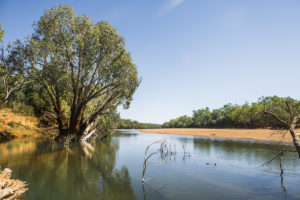27 June 2018
WA’s Fitzroy River catchment is recognised for its outstanding natural and cultural heritage, but perhaps less so for its significant social complexity. There are at least 30 Aboriginal communities living on lands recognised under seven native title determinations, numerous towns and close to 50 pastoral stations, a great many of which are owned by Aboriginal people. In a new article published in The Conversation, Hub project leader Professor Sue Jackson and researcher Dr Sarah Laborde describe the recently formed Martuwarra Fitzroy River Council, established to represent Aboriginal interests in the management of the Fitzroy River and the people united by its flow and a common sense of custodianship. By engaging with government and other parties, the Council has the potential to support the WA government’s integrated catchment planning process in a manner that addresses weaknesses in standard approaches to catchment management. With support, the Council could bring together representatives of every group that can speak for and has knowledge of the river and land within its catchment, including Wilinggin, Kija, Bunuba, Gooniyandi, Walmajarri, Nyikina Mangala and Warrwa. It could also facilitate the inclusion of Aboriginal governance principles, ecological knowledge and socio-economic objectives in land and water policy. Finally, it could contribute to adaptive management by developing long-term relationships with all stakeholders in the catchment. With a suite of Hub projects in the Fitzroy, including a project led by Professor Jackson investigating Indigenous water needs of the river, the Council will also be a valuable way for all Hub researchers to engage with Indigenous groups across the catchment.

Fitzroy river on Nyikina-Mangala country
Want to know more about the Resilient Landscapes Hub's activities and our research into practical solutions to environmental problems? Stay informed about activities, research, publications, events and more through the Hub newsletter.
"*" indicates required fields